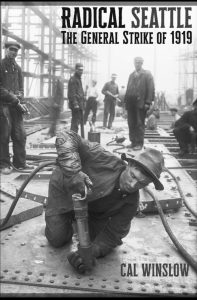Radical Seattle: The General Strike of 1919
 Radical Seattle: The General Strike of 1919, by Cal Winslow (New York: Monthly Review Press, 2020).
Radical Seattle: The General Strike of 1919, by Cal Winslow (New York: Monthly Review Press, 2020).
The Seattle General Strike lasted only five days, but people have been fighting over what it means for a hundred years. Cal Winslow raises this discussion to a new level. Sticking close to the workers themselves, he shows us why the strike matters.
Radical Seattle takes its time getting to the strike itself. Early chapters are organized thematically, not chronologically, so there is some repetition. We are told, three different times, that loggers would flee the wet woods and spend the winter on Seattle’s Skid Road (pp. 44, 52, and 72). But Winslow’s strategy pays off. He shows us how Seattle became a major modern city, rooted in shipbuilding, and how the workers in Seattle’s 120 craft unions came to favor industrial unions and the closed shop. He shows us how cooperatives, the Socialist Party, the Soviet Revolution, and especially the IWW’s struggles in the Pacific Northwest, contributed to the outlook of Seattle’s workers.
By the time Winslow gets to the Everett massacre, in Chapter Four, the narrative carries us along. In 1916, Everett timber workers, including some Wobblies, were striking, and being violently repressed. To give support, Seattle’s IWW members rushed to Everett via boat and were fired on by the authorities and vigilantes at the Everett dock; there were many casualties. Winslow wants us to know this history for its own sake, and also because the Everett massacre pushed Seattle’s workers to the left, like the Peterloo massacre in nineteenth-century England pushed English workers to the left (p.97).
Radical Seattle shows how the Wobblies helped make Seattle radical. Winslow’s larger point –developing the great insight of his mentor, EP Thompson– is that Seattle’s workers in 1919 were not just reacting to the conditions of the moment. Their thinking was shaped by earlier events like the Everett massacre and by the repression of Wobblies and Socialists after the US entered WWI. In Seattle, there was growing collaboration on the ground between Wobblies, Socialists, and trade unionists; they shared the same street corners, the same stages, the same demonstrations (pp. 139 and 142). Making good use of newspapers, especially the Seattle Union Record, obscure MA theses, and wonderful archival photos, Winslow explains how Seattle became different, how its workers became powerful.
He is careful to note that radical equality was a value for some but not all of Seattle’s white workingmen. There was racism toward the small minority of black workers and the larger minority of Japanese workers. Seattle was a union town, but the Japanese workers had their own segregated locals. Winslow tells their story. He is even better at integrating the struggles of women workers into his narrative. We find out about organizing by laundry workers and hotel maids and waitresses; we listen to the debates about the rights of wives to work; we meet women organizers like Anna Louise Strong, Kate Sadler, and Louise Olivereau.
By the time we get to 1919, we understand that the militants in the labor movement, who were a minority elsewhere, were the majority in Seattle. James Duncan, leader of Seattle’s trade union movement, supported industrial unions, fought for closed shops, and openly opposed Samuel Gompers’ leadership of the AFL at national conventions. He was not a radical but he was open to radicals and worked with them; like them, he wanted all labor contracts to expire at the same time, so that workers could strike together. In Seattle, in contrast with the national AFL, local union leaders valued working-class solidarity more than craft exclusivity.
The Seattle General Strike of 1919 was an expression of class solidarity. 30,000 shipyard workers who were on strike asked other unions to join them. Workers from all of Seattle’s other unions joined, effectively shutting down the city. Suddenly the workers were responsible for the city. How would people eat? Dispose of garbage? Get the prescription drugs they needed? Get buried? Who would do the hospital laundry? What services would the strike committee reopen, to make life possible? Winslow shows us the streets quiet, and the feeding stations, union halls, co-op markets and neighborhoods bustling with life. He insists that it is still the only time that workers in the US ever really ran a city (p. 218).
Threatened with massive violence by the federal government, strike leaders ended the peaceful general strike after five days. Strike opponents and some historians see it as a failed revolution. In proclaiming the strike a success, Winslow follows the lead of the strike committee, which published its own history: Seattle’s workers “learned how a city is taken apart and put together again.” (p. 214). And when we finish this powerful book, we too have learned how a city may be taken apart and put back together again.
Reviewed by Steve Golin, Professor Emeritus of History. Bloomfield College, Bloomfield, New Jersey.
